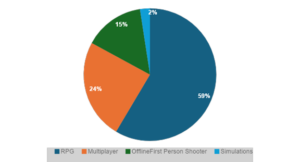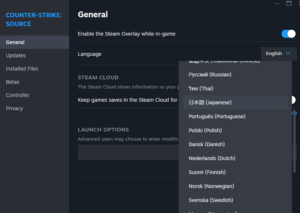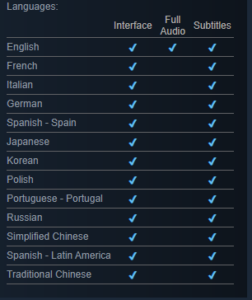Final-year Japanese student James Mather is sharing his extensive knowledge about video games and language learning, based on his thesis ‘Methods and Impacts: How University Students Utilise Video Games for Learning Japanese’. This interesting text is insightful for both language learners and tutors. Read more below!
Video Games and language learning should be deemed as the perfect way to learn your language. They’re accessible and You can engage with your target language in a fun familiar environment and expose yourself to almost every element of a language one could want from the comfort of your own chair.
While it sounds great on paper, using Video Games for language learning can have negative results if misused. The broad scope of ‘Video Games’ doesn’t help either as games can range from standard platformers to geopolitical trade-related sandboxes which will fluctuate in difficulty and relevance to you as a learner. (unless you’re going into a career which involves geopolitical trade relations though I wouldn’t recommend that type of game for learning early on)
I’m James, a final-year student at York St John awaiting graduation. During my Four years here, I regularly used video games to assist in my Japanese language development with both positive and negative outcomes. To see if others had these experiences, my dissertation ‘Methods and Impacts: How University Students Utilise Video Games for Learning Japanese’ situated itself around interviewing fellow York St John students and understanding their experiences with Video games both good and bad. Combined with past academic literature and thematic analysis, some incredibly useful and interesting results have been found. While this was situated around Japanese, I see no reason why this won’t apply to languages like Korean.
While I won’t bore you with the long academic literature, it’s important to note certain things about Video Games before rushing headfirst into them. So, regardless if you’re just starting your language journey or have been learning this language for many years, this blog post should assist you not only in how to use video games in your target language, but how to pick them, how to enjoy them and how to avoid any demotivational effects that may come with them. It is important to note however that while patterns emerged from the interviewed students, every student is different and learns through different methods. This blog should only act as a guiding hand and what may work for some may not work for others. As always, don’t be disheartened, stay willing and do what’s best for you!
The Good
As said at the beginning, Video games can be an incredibly effective tool for language learning for several reasons. Only in games can one find an immersive environment where the target language is used naturally. Everything you interact with is done from your control. This can include dialogue, menus, and written text, allowing you to see and hear the language in context. This immersion helps reinforce learning and makes it easier to understand how the language is used in real-life scenarios.
Many of the participants enjoyed games such as RPGs, GRAND THEFT AUTO and VALORANT due to similar words, objectives and voice lines appearing multiple times, assisting in context-based learning and long-term retention.

Who would have thought a crime simulator could provide words you’ll use in your daily life frequently? Maybe not the one pictured.
Games of similar genres by nature tend to be repetitive. Learn the words of a UI or menu and you’ll no doubt see them appear in almost every other game. This can make navigating new games far easier and less stressful. Furthermore, they’ll most likely crop up in day-to-day study meaning you can show off to your teacher, classmates or even just yourself.

Someone who’s played Stardew Valley needs to tell me what’s in this strange capsule
For that extra challenge, games which require you to solve puzzles or complete quests in your target language force you to comprehend and utilise vocabulary and grammar in a practical way. This active engagement can significantly improve retention and understanding.

Skyrim is getting on in years but you’d be hard-pressed to find a better game to learn with if you love fantasy RPGs and are looking for a healthy challenge. It’s fully voice-acted in Japanese too!
Finally, you can tailor games to YOU. The variety of genres and settings that video games offer is insane. Whether you prefer fantasy role-playing games, realistic simulations, or historical adventures, you can find games that suit your interests while providing language practice. This variety keeps learning enjoyable and engaging, making it more likely that you will stick with it in the long run. Intrinsic Motivation to learn more is something very exclusive to video games. Some students I interviewed wanted to know every word in the quest description, and it pushed them to learn as much as possible without resulting in exhaustion as they could INSTANTLY apply this knowledge. For myself, I found that the more I played and learned, the more it could be used in daily life and other games too!

Firing up an MMORPG with friends and using your target language EXCLUSIVELY can be one of the most entertaining and fantastic ways to learn your language and practice in a genuinely meaningful space. It’s also academically proven to increase language retention, comprehension and willingness to communicate!
The Bad
Unfortunately, Video games are a genuine double-edged sword for language learning. Every participant I interviewed suffered some demotivational effects when using Video Games to learn Japanese. Many of which could have been avoided.
A pattern the participants did when starting to use Video Games to learn Japanese was to default straight to the games they were comfortable with. While this is not a bad thing as familiarity is a fantastic crutch, it can be awful when you’re interacting with a video game to learn a language.
I won’t go into too much detail here, but a man called Krashen put forth the second language acquisition hypothesis of I+1. (any TESOL students best prepare to learn more about that) That means language acquisition best occurs when interacting with materials that are just slightly above your level. One can then imagine what happens if someone who just learned Hiragana attempts to play their favourite geopolitical trade-related grand strategy sandbox game. It doesn’t go well.
Keep this in mind when choosing the game to play. Engaging with something far above your current level may result in negative and motivational effects. While you’ll never understand everything going on, being able to match and engage with the environment will always lead to happy and healthy second language acquisition. If you’re feeling overwhelmed, don’t be downhearted as it might just be a bit too early. Try to find games you enjoy that are simplistic in nature or are less intrusive on you. Remember, Video games are great to learn and relax with. You do not want to turn it into a chore.

Some participants loved pokemon as it was easy to understand and provided ample opportunity to learn with
At first, it may be difficult to determine what level you are. Preparing for the JLPT exam can provide a solid foundation to see how you fare.
You’ll be pleased to learn however that all of the 4th year students I interviewed were able to return to the games that gave them trouble and were able to interact with them in a healthy i+1 scenario. This is the importance of Traditional language learning methods such as classroom time, textbooks and flash cards. So while games do have appeal, remember to build up your core knowledge before entering. Judging from past literature and the study I conducted, Video Games should never be used as a substitute for genuine language learning.
Remember too that not all games are created equal in terms of language learning potential. Some games might use highly specialized vocabulary that is not useful for everyday conversation, while others might be too difficult for beginners, leading to frustration.
Additionally, it is easy to get caught up in the fun of gaming and lose sight of the educational goal. Spending hours playing a game without actively engaging with the language elements can lead to wasted time. It’s important to remain mindful of your language learning objectives and choose games that provide a good balance of entertainment and educational value.

Online shooters can be great fun, but remember to take note of the words and phrases around you. Even better, if you can play with natives and friends!
In summary, keep well in mind the theory of I+1 and the sort of game you’re interacting with. Knowing your JLPT level too can also assist greatly in choosing the type of game to interact with.

My participants identified RPG games as the most beneficial. That came from all participants ranging from N4 – N2 levels as their repetitive environment is perfect for language learning!
Methods to get started
Games can provide great environments for passive learning, but It’s important to note that not all vocabulary development stems from mindset. All the 4th year students actively expand their vocabulary using methods like the Jisho online dictionary (or the Korean equivalent Naver) alongside flashcard websites like Anki or Brainscape (I personally recommend brainscape) With Video games, you will run into unknown kanji. Through Jisho, you can find definitions and translations and then use these meanings to create flashcards. Once again, this pattern emerged naturally amongst the 4th year students though 2nd year students didn’t seem aware of this approach. As such, it’s a good idea to keep this Jisho Method in mind.
Using flashcards alongside online dictionaries solidifies language acquisition, making the learning process more effective and enjoyable for you as a player!
Usage of Video Game Subtitles
This goes without saying but subtitles are your greatest ally regardless if they’re in Japanese or English. Both my study and past academic research on subtitles showed their passive benefits regardless of setting such as Japanese audio with English subtitles resulting in passive benefits to a student’s pitch accent and tone.
The Students who used Jisho and other third-party tools also found that games with subtitles were beneficial. Subtitles + Jisho + Flashcards do make this a great and easy-to-use process applicable to any game. This bimodal approach, combining audio and visual cues, enhances listening comprehension and vocabulary improvement.
Keep in mind though that when mixing English and Japanese, there are some concerns about the accuracy of translations. Regardless, however, the educational value of subtitles is clear, especially for learners at lower proficiency levels. As your language proficiency progresses, you may shift to using Japanese subtitles and audio entirely once you feel comfortable. Remember, go at your own pace and take it slow.
Conclusion
So, how does that sound? As I said at the beginning, it may take some time to be able to use Japanese Video games to improve your language learning and don’t expect video games to remove the traditional aspect of language learning. If you keep i+1 in mind, know about 3rd party websites such as Jisho and flashcards as well as ensure you’re engaging well, you’ll see how video games can be the perfect source of reading, listening, comprehension and everything in between. Learning is an individualistic trait, but I hope this has provided you with great insight when it comes to using Video Games to learn.
I also urge people to try playing multiplayer games with friends both native and non-native. It’s a fantastic way to use what you have learned in a space that requires it.
Access to every target language game you could want
If you believe you’re ready to delve into the world of Japanese and Korean Video games, you may be surprised at how easy it can be to get Japanese versions of your favourite Video Games for free. (sort of)
XBOX
If you own an Xbox One and a game pass subscription, congratulations, you now have access to 450+ of your favourite games in Japanese or Korean ready to download. All you need to do is change both your CONSOLE LANGUAGE and REGION to Japanese and Japan respectively. (or Korean/Korea) Once done, you can download any self-purchased game or game pass game in the Japanese or Korean equivalent. Please note that such region access brings censorship or changes to the game that may feel unfamiliar. Other games may not be available at all. Even if you bought them! Banned games will still appear but may tell you you do not own the license. To fix this, switch your region back to the UK.

Games such as halo MCC have full Japanese Voice and Text and can be changed at will
STEAM
Steam is by far the most user-friendly for language selection. You don’t need to change any region settings. All you need to do is right-click on a desired game and go to properties then languages.

Keep in mind however that every language is not available. Before buying a game, scroll down the store page and you’ll see a very useful language availability menu. This is perfect for helping you choose games.

Unlike Xbox, changing languages DOES NOT result in censorship of the game. An uncensored version of Skyrim will stay uncensored with only the language changing.
PLAYSTATION 5
Bad news for PS4/PS5 owners. Unfortunately, the playstation has an annoying habit of being very exclusive when it comes to region locking. While region lock is not on the PS5 physically, it is digitally. This means that changing your language or region will not change how the game downloads. You can go down the physical import route, but this is costly and time-consuming. (My advice, when you study abroad go to BOOKOFF or 플스방 Multibang)
The only way around this is by following a youtube tutorial on making a Japanese/korean account (or if you’re in Japan/korea, just make a new one) though this can be tricky as you need to spoof address data. Furthermore, only PAYPAL or prepaid cards work on Japanese accounts and you can’t purchase or play games rated Z (Pegi 18) without a Japanese credit/debit card. It is doable, but unfortunately, it’s the most difficult way. I am unsure about Korean accounts.
Some games do have Japanese built-in like Ghost of Tsushima, but the majority don’t.

You’ll need to take extra steps to hear Kratos in your target language
Well, that’s all I can offer. I hope this blog post has been of use to you! If you have any questions, need any advice, or just want to discuss in general, please feel free to get in touch.
